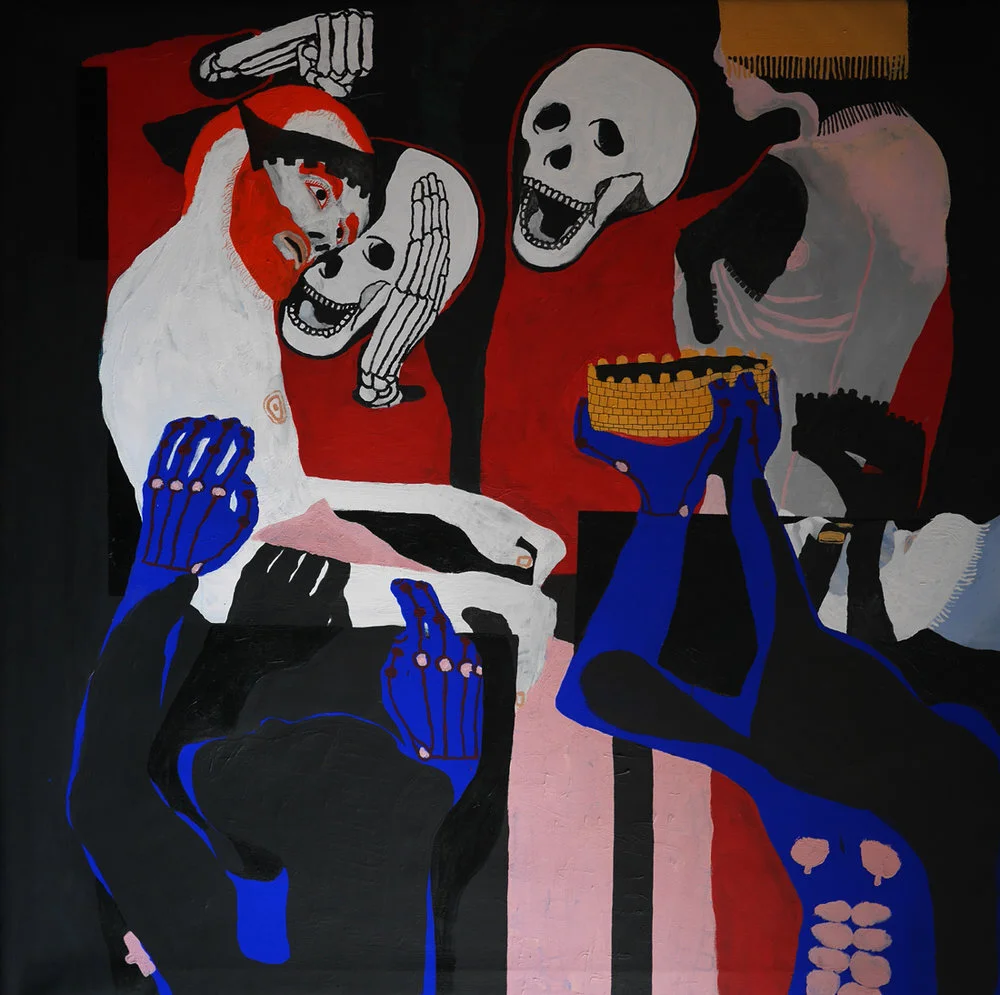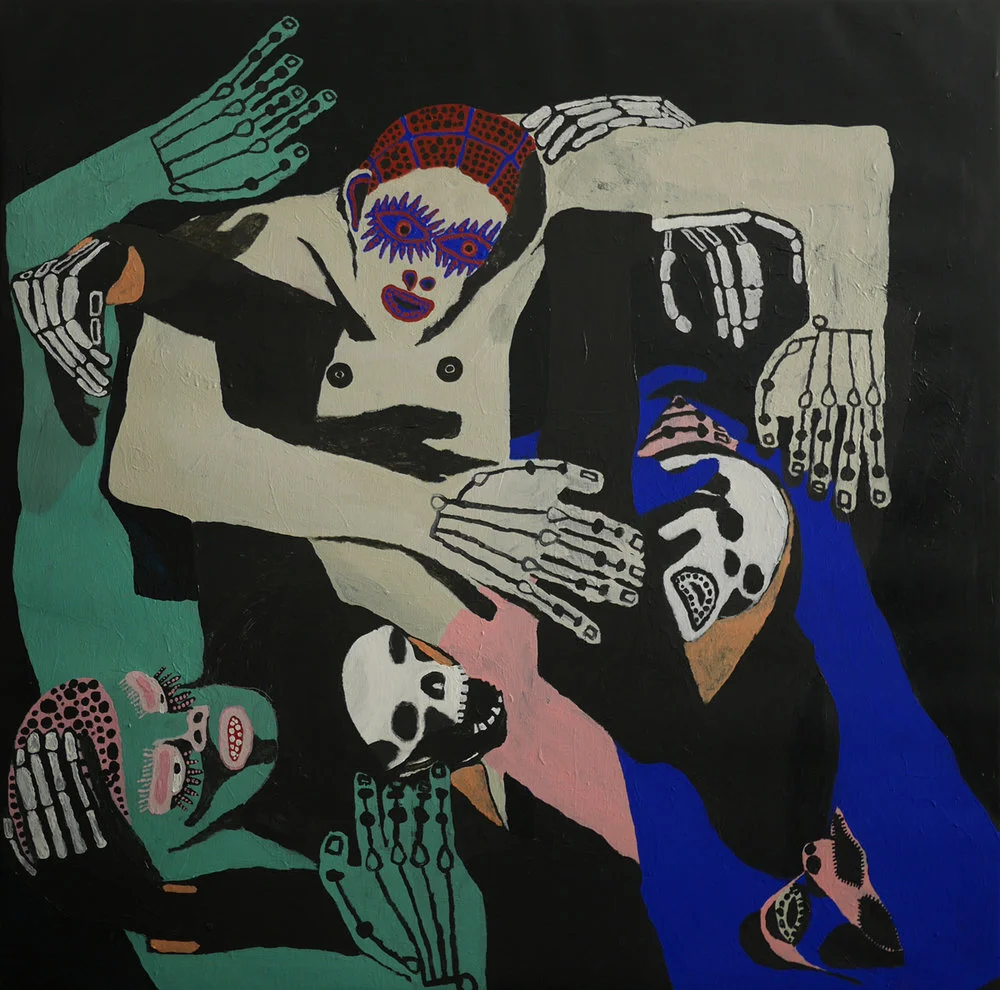INTERVIEW WITH ARTIST MOLEY TALHAOUI
Moley Talhaoui with his son at this studio in Stockholm. Image courtesy of the artist.
Moley Talhaoui’s studio in Södermalm, Stockholm reads like a physical extension of the genuine artistry the artist puts into everything he does. Newspaper clippings and photos are arranged around large canvases stretched across the high-rise walls that make the large open-plan space, framing the intricately patterned and darkened worlds of his spindly, hard-edged characters. Drawings on paper are stacked on the various desks and shelves, and no single object; chair, sofa, mirror, pillar or penholder is left unmarked, scrawled or doodled on.
Born in Sweden to Moroccan parents, Moley is a self-taught artist who mainly works with acrylic and oil on canvas. Visible is the frail pencil-work of Gustav Klimt’s early studies and his gestured hands and fingers, Egon Schiele’s brash, twisted and contorted bodies, and the free-form expression of Jean-Michel Basquiat. Edged with heavy influences from his Moroccan cultural heritage and the intricacies of North African fabrics and ceramics, Moley's aesthetic seemingly straddles opposing visual languages combined with a dark, contemporary gaze that is very much his own.
Moley Talhaoui - Untitled (2017) 130cm X 130cm, acrylic and oil on canvas. Courtesy the artist.
Moley Talhaoui - Untitled (2017) 130cm X 130cm, acrylic and oil on canvas. Courtesy the artist.
From his studio in Stockholm, Moley talks us through his practice in his own words:
How would you describe your creative process? Pretty simple; first I hone in on my feelings in that moment, and work through the inner conflict of why I do what I do, and when each half of my consciousness is in the same place and in agreement that all humans seek to achieve is actually without meaning, then I can connect my soul to something bigger and allow myself to process the information visually. That connection is lost occasionally a little while later and I am often left standing there with my unfinished work feeling the child inside myself that has to continue to take control over the situation and solve what it was supposed to be in the first place.
What would you say has affected your style as an artist? The fearlessness and absolute freeness that is evident in Basquiat’s work and the harsh expressiveness of Ferdinand Hodler and Egon Schiele. Also my cultural roots from Rif, a mountainous region of Northern Morocco and the Sahara desert. The Berber idiom, voodoo and West-Africa are things that always influence me, but are more on the outskirts of my artistic atmosphere.
Do you have a studio routine? I paint when I feel like it most, so it varies.
Moley Talhaoui - Untitled (2016) 24x35cm, pencil on paper. Courtesy the artist.
Moley Talhaoui - Untitled (2016) 24x35cm, pencil on paper. Courtesy the artist.
Moley Talhaoui - Untitled (2016) 24x35cm, pencil on paper. Courtesy the artist.
“I feel what I want to achieve, I see that come out over time. I don't have a finished image inside of me. Sometimes I paint in my head, but it seldom becomes what I saw originally because I am really susceptible to that which comes to me spontaneously.”
Name an emotion that you like to work with. Conflict.
Do you throw pieces away that you don't like or revisit them later? I paint over what I don't like. I like the idea of seeing the structure of what could have been, what might come into view under different light sources.
You use a lot of typography in your paintings and drawings, why? They function like memos, I allow thoughts that feel interesting for me in the moment come through in the piece I am working on. Thoughts that rhyme can be called poetry, but it doesn't really feel that way for me, I don’t follow any rules and I let things that want to rhyme, rhyme, but I don't strive to achieve anything in particular.
What do you find difficult in the process of painting a new piece? When I break away from it and have to begin the process again.
What do you find most fun? When I fall into a trance.
What colours do you connect with and why? All colours, as long as they are set against a black background.
Moley Talhaoui - Untitled (2017) 24x35cm, pencil on paper. Courtesy the artist.
Moley Talhaoui - Untitled (2017) 24x35cm, pencil on paper. Courtesy the artist.
Do your paintings have stories/narratives? Some works do but others I try to tease out the meanings myself after they are done.
Do you listen to music when you work, and if so, what? Yes, I do. It varies, I had a good stint with Bembeya Jazz National recently.
What/who inspires you lately? Middle-aged women that express themselves using some form of spiritual process like yoga or meditation as their starting point and painting as a medium to express that spirituality. It has a certain charm, I like that unapologetic tacky-ness in lotus and Buddha paintings.
What interests you, aside from creating art? I listen to other intellectuals ideas about human consciousness and what that is, ranging from philosophies within Buddhism, I-Amness, Solipsism etc. people like OSHO, Papaaji Satsang, Plato, Alan Watts and others.
You recently had your first child, has being a father changed anything for you as an artist? Nothing has really changed, it feels like he has always existed even though he is only just turning 2 years old. But if there was something it would be that I do this to be able to support us, nothing more.
In what contexts do you most want to see your work viewed? In the home, a gallery or museum and public spaces like a subway station or mental hospital. Maybe in the home of some corrupt politician, what I do bears the spirit of justice and order, so in the presence of things that are wrong it can bring about some order. What I do is not for people who make money on the back of other people’s backs, they wouldn't want to bring that frequency into their homes, it wouldn't bring anything good to them. Or maybe it would be good because it would clear them of the darkness that leads them to take the selfish actions that contribute to the imbalances that exist in our world.
What are your aspirations as an artist? What is the dream end-point? I live in an awakened state, so I don’t dream, I only have each day to look forward to and hope for something - what is to be, must be - OJALA!
Where do you see yourself in 20 years? Hopefully alive!









